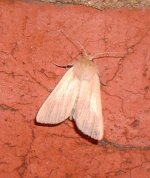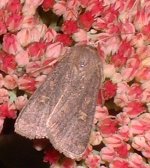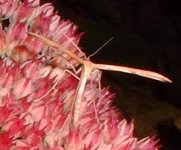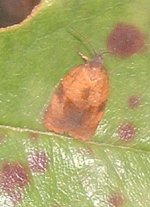-
Welcome to BirdForum, the internet's largest birding community with thousands of members from all over the world. The forums are dedicated to wild birds, birding, binoculars and equipment and all that goes with it.
Please register for an account to take part in the discussions in the forum, post your pictures in the gallery and more.
You are using an out of date browser. It may not display this or other websites correctly.
You should upgrade or use an alternative browser.
You should upgrade or use an alternative browser.
help needed with moth ID (1 Viewer)
- Thread starter Surreybirder
- Start date
More options
Who Replied?Hi CJW & Ken
I can't find Common Wainscot in Skinner but it certainly looks like a Wainscot species. Has it got another name CJW?
Try submitting to UK moths at @ www.moths.force9.co.uk
Went to a moth trapping session with RSPB several weeks ago and found it really interesting but daunting. The problen is that text books like Skinner show them laid out whereas normally their wings are folded!
Good luck!
I can't find Common Wainscot in Skinner but it certainly looks like a Wainscot species. Has it got another name CJW?
Try submitting to UK moths at @ www.moths.force9.co.uk
Went to a moth trapping session with RSPB several weeks ago and found it really interesting but daunting. The problen is that text books like Skinner show them laid out whereas normally their wings are folded!
Good luck!
Surreybirder
Ken Noble
Thanks, Phil and CJW!
Surreybirder
Ken Noble
Surreybirder
Ken Noble
Surreybirder
Ken Noble
PhilW said:
In case anyone's interested, the correct URL is
http://cgi.ukmoths.force9.co.uk/index.php
Surreybirder
Ken Noble
CJW said:Hi Ken,
difficult to tell because of the exposure but it's one of the Wainscot family, I would guess Common Wainscott because of the lack of streaking/veining.
Chris
Update: I sent the photo to our macromoth county recorder. He said it could be a common or a smoky wainscot.
Have a look at
http://cgi.ukmoths.force9.co.uk/show.php?bf=2199
Last edited:
Surreybirder
Ken Noble
Surreybirder
Ken Noble
And while I'm at it....
Two of these on our sedum tonight. Any ideas?
PS I've now moved this photo TO THE GALLERY
Two of these on our sedum tonight. Any ideas?
PS I've now moved this photo TO THE GALLERY
Last edited:
scampo
Steve Campsall
Someone mentioned that Skinner is a let down because many spoecies are photographed pinned down in unnatural wing positions. That's true and a shame - the second edition of this book really is a disappointment from that perspective.
But - a new book, just out and in short supply, called "Field Guide to the Moths of Great Britain and Ireland" (see: http://books.reviewindex.co.uk/reviews_uk/0953139921.html) overcomes this disadvantage of Skinner's and is very useful indeed having far superior illustrations (but sadly no photos except of larvae).
This must surely now rate as a "must-have" guide as it is easily the best single-volume guide for anyone keen on moth trapping and a great accompaniment for Skinner (which in every other way is surely outstanding). Sadly it is £29-95 - quite a high price, especially for a paper back.
Steve Campsall
But - a new book, just out and in short supply, called "Field Guide to the Moths of Great Britain and Ireland" (see: http://books.reviewindex.co.uk/reviews_uk/0953139921.html) overcomes this disadvantage of Skinner's and is very useful indeed having far superior illustrations (but sadly no photos except of larvae).
This must surely now rate as a "must-have" guide as it is easily the best single-volume guide for anyone keen on moth trapping and a great accompaniment for Skinner (which in every other way is surely outstanding). Sadly it is £29-95 - quite a high price, especially for a paper back.
Steve Campsall
Last edited:
harry eales
Ancient Entomologist
campsall said:Someone mentioned that Skinner is a let down because many spoecies are photographed pinned down in unnatural wing positions. That's true and a shame - the second edition of this book really is a disappointment from that perspective.
But - a new book, just out and in short supply, called "Field Guide to the Moths of Great Britain and Ireland" (see: http://books.reviewindex.co.uk/reviews_uk/0953139921.html) overcomes this disadvantage of Skinner's and is very useful indeed having far superior illustrations (but sadly no photos except of larvae).
This must surely now rate as a "must-have" guide as it is easily the best single-volume guide for anyone keen on moth trapping and a great accompaniment for Skinner (which in every other way is surely outstanding). Sadly it is £29-95 - quite a high price, especially for a paper back.
Steve Campsall
Having a very large collection of Butterfly and Moth identification books in my library dating back to the 1830's I must agree that the new "Field Guide to the Moths of Great Britain and Ireland" is the best book for moth identification published so far. Nearly all of the illustrations show a near natural pose as one would find the species in the wild. Expensive perhaps, but compared with many other natural history publications it is very good value for money. I wouldn't swap my copy for anything. If you want only one book on moths, this should be it.
Harry Eales.
CJW
Hit-and-run WUM
I haven't seen this new book yet chaps, so I can't comment on it. What I would ask is "do the plates show the underwings of all species?", if so then it sounds like a good buy if the answer is "no", then I'll stick with Skinner - it's never let me down yet.
Showing moths in their natural postures is all well and good for helping narrow an insect down to family, but completely useless in identifying many species. Are the specimens in the plates actual size? Are they drawings or photographs taken under controlled/neutral lighting?
Showing moths in their natural postures is all well and good for helping narrow an insect down to family, but completely useless in identifying many species. Are the specimens in the plates actual size? Are they drawings or photographs taken under controlled/neutral lighting?
Surreybirder
Ken Noble
PhilW said:OK I give up!
CJW - can't find Square Spot Rustc in Skinner. Can find Rustic & Square Spot but neither look like photo submitted by Surreybirder! Help the uninitiated please.
PhilW, try clicking HERE
(Of course, now that CJW has identified it, I had no trouble finding it on the above site.. finding one you don't have a clue what it is is a completely different kettle of caterpillars, so to speak).
Ken
harry eales
Ancient Entomologist
PhilW,
The second edition of Skinner shows The Square-spot Rustic on page 97 and plate 28. Not an uncommon species and hardly likely to have been left out of the first edition. Try looking in your edition under the scienfic name Xestia xanthographa.
Harry Eales.
The second edition of Skinner shows The Square-spot Rustic on page 97 and plate 28. Not an uncommon species and hardly likely to have been left out of the first edition. Try looking in your edition under the scienfic name Xestia xanthographa.
Harry Eales.
Users who are viewing this thread
Total: 2 (members: 0, guests: 2)







